Agriculture is a cornerstone of modern civilization. However, the agricultural supply chain remains fraught with inefficiencies, fraud, and lack of transparency. From the moment a crop is harvested until it reaches a consumer’s table, numerous intermediaries handle the produce. This complexity creates room for errors, counterfeiting, and a lack of accountability. Fortunately, blockchain technology offers a promising solution. By using blockchain in the agricultural supply chain, stakeholders can ensure transparency, security, and efficiency.
What is Blockchain Technology?
Blockchain is a decentralized digital ledger that records transactions across multiple computers. The data stored on a blockchain is secure, transparent, and immutable. This means no one can alter the information once it’s recorded. Each block contains details of transactions and is linked to previous blocks, creating a chain. This structure helps build trust, as every participant can verify the authenticity of transactions.
In agriculture, blockchain technology can track the movement of goods at every stage of the supply chain. This includes farming, processing, packaging, transportation, and retail. Ultimately, with blockchain, everyone involved — from farmers to consumers — can access real-time information about the produce’s journey.
Challenges in the Agricultural Supply Chain
Before we delve into how blockchain can help, it’s crucial to understand the current challenges. The agricultural supply chain is complex, involving multiple processes and intermediaries. The following are key issues:
Lack of Transparency:
It’s often difficult to track the origin of products. This lack of transparency can lead to fraud and mislabeling.
Inefficiency:
Traditional supply chains rely heavily on paperwork. Manual processes slow down the movement of goods and introduce errors.
Counterfeiting:
Fraudulent practices like substituting premium goods with lower-quality items are common. This damages trust and can lead to health risks.
Food Safety Issues:
Without proper traceability, identifying the source of contaminated food becomes challenging. This delays responses to food safety crises.
Farmer Exploitation:
Many farmers struggle with unfair compensation due to a lack of visibility in pricing and distribution.
Blockchain technology addresses these challenges by creating a transparent, efficient, and secure system. Let’s explore how this works in practice.
Benefits of Blockchain in the Agricultural Supply Chain
Enhanced Transparency
Blockchain creates an immutable record of each step in the supply chain. From planting to harvesting, each action is logged. When produce changes hands, the transaction is recorded. This transparency ensures that everyone, including the end consumer, can verify where the food came from. For instance, a consumer can scan a QR code on a product to see its entire journey.
Improved Traceability
In the event of a food safety issue, traceability is critical. With blockchain, identifying the origin of a contaminated product becomes quick and efficient. Each transaction on the blockchain is time-stamped and recorded. In addition, If an issue arises, stakeholders can trace it back to the exact farm or processing facility. This reduces the time needed to identify and contain outbreaks.
Reduction in Fraud and Counterfeiting
Counterfeit goods are a major issue in the agricultural industry. Premium products are sometimes replaced with cheaper alternatives. Blockchain prevents this by maintaining a transparent ledger. Any fraudulent activity becomes immediately visible. This helps build trust among consumers and ensures that they receive genuine products.
Increased Efficiency
Blockchain reduces the need for manual record-keeping and paperwork. Smart contracts automate transactions and approvals. For example, once a shipment arrives at its destination, the smart contract can automatically release payments. This reduces delays and administrative costs. Additionally, digitized records streamline audits and quality checks.
Fair Compensation for Farmers
Blockchain helps ensure that farmers receive fair compensation. Thus, By providing a transparent pricing system, farmers can see how much their produce sells for at each stage. This visibility reduces exploitation by middlemen. Furthermore, blockchain enables direct transactions between farmers and retailers, reducing intermediaries.
How Blockchain Works in the Agricultural Supply Chain
Step 1: Data Collection on the Farm
The process begins with data collection at the farm level. Farmers record details such as the type of crop, planting date, fertilizers used, and harvesting methods. This information is entered onto the blockchain. Sensors and IoT devices can also be used to collect real-time data, such as soil quality and weather conditions.
Step 2: Processing and Packaging
Once harvested, the produce is sent to processing facilities. Here, details like processing methods, packaging date, and quality checks are recorded. Each transaction is logged on the blockchain. This ensures that the product’s journey remains transparent.
Step 3: Transportation
When the produce is transported, logistics companies update the blockchain with shipment details. Additionally, this includes the route taken, temperature conditions (for perishable goods), and delivery status. If any issue occurs during transport, the blockchain provides immediate visibility.
Step 4: Retail and Consumer Access
Upon reaching retail stores, the final transaction is logged. Consumers can access the blockchain record by scanning a QR code. This provides information about the product’s origin, journey, and handling. So therefore, This transparency builds trust and confidence in the food supply.
Real-World Examples of Blockchain in Agriculture
Several companies have already implemented blockchain in their supply chains:
IBM Food Trust:
This blockchain network helps improve food traceability. Major retailers like Walmart use it to track produce from farm to shelf.
TE-Food:
A blockchain-based platform that tracks livestock and fresh food. It helps reduce food fraud and improve supply chain transparency.
AgriDigital:
This platform uses blockchain to manage grain supply chains. It ensures fair payment and efficient transactions for farmers and buyers.
Challenges in Implementing Blockchain
While blockchain offers numerous benefits, some challenges remain:
High Initial Costs:
Implementing blockchain requires investment in technology and training. For small-scale farmers, this can be a hurdle.
Technical Knowledge:
Farmers and supply chain participants need to understand blockchain technology. Training and education are essential.
Data Privacy:
While transparency is crucial, some stakeholders may have concerns about sharing sensitive information. Balancing transparency and privacy is key.
Scalability:
As more participants join the network, the system must handle increasing amounts of data. Scalability solutions are needed for broader adoption.
Conclusion
Blockchain technology holds the potential to revolutionize the agricultural supply chain. By ensuring transparency, traceability, and efficiency, blockchain helps solve long-standing issues. Furthermore, Consumers can trust the food they buy, while farmers receive fair compensation. Although challenges exist, the benefits far outweigh the hurdles. As more stakeholders embrace blockchain, the journey from farm to fork will become more transparent and trustworthy. Hence, This transformation can ultimately lead to a more efficient, secure, and sustainable agricultural industry.



































